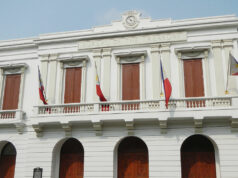BSP cuts policy rate to record low
THE BANGKO SENTRAL ng Pilipinas (BSP) fired off another 50-basis-point (bp) cut in policy rates in an off-cycle meeting to bring borrowing costs to record lows in a bid to boost lending to support the economy in the middle of the coronavirus disease 2019 (COVID-19) crisis.
“BSP cut key policy rate by 50 bps,” BSP Governor Benjamin E. Diokno told reporters in a Viber message on Thursday. The reduction will take effect today (April 17).
“This is to strongly encourage lending to various sectors, especially to the most vulnerable, amid the COVID-19 pandemic,” he said on Twitter.
This brought the key rate or the overnight reverse repurchase rate to 2.75%. Accordingly, interest rates for the central bank’s overnight deposit and lending facility have been trimmed to 3.25% and 2.25%, respectively.
These rates are the lowest on record and also since the BSP shifted to an interest rate corridor in 2016.
The cut came less than a month after the 50-bp reduction in a scheduled Monetary Board meeting on March 19, which took effect on March 20.
The Monetary Board meets every six weeks to review its policy settings. But with the latest rate cut, Mr. Diokno said they “see no reason to have another policy meeting on the next scheduled date (May 21).”
“Monetary policy works with a lag and it is the sense of the MB that a cut of 125 bps for the first half of the year is appropriate. We continue to monitor domestic and international developments, however,” he said.
For this year alone, the central bank has slashed rates by a total of 125 bps after a 25-bp cut on Feb. 6. This followed 75 bps in cuts implemented in 2019. This means the BSP has completely unwound the 150 bps in hikes done in 2018.
The central bank chief hinted earlier this week that the COVID-19 crisis could warrant a “deeper cut” in rates to ensure a “soft landing” for the economy, and said the key rate could drop below its 3% level back in 2018, which was before the BSP tightened its stance to arrest rising inflation.
Mr. Diokno said a slower inflation outlook amid falling oil prices is supportive of this dovish stance.
Headline inflation in March eased to 2.5% from the 2.6% seen in February and the 3.3% in March 2019. This brought the year-to-date inflation average to 2.7%, which is within the 2-4% target for 2020 and also above the 2.2% expected by the BSP for the year.
RIGHT TIME
The rate cut, although off-cycle, came at the right time given dimming economic prospects due to the pandemic, analysts said.
“There is no better time to aggressively cut local policy rates than now as monetary easing measures are really intended for times such as this COVID-19 pandemic that has huge economic fallout,” Rizal Commercial Banking Corp. Chief Economist Michael L. Ricafort said in a text message.
Jonathan L. Ravelas, chief market strategist at BDO Unibank, Inc., said the move is part of the government’s strategy to soften the economic impact of the outbreak.
“I think the idea of the rate cut is that this is still part and parcel of the measures done by the government to eventually mitigate the impact of COVID-19…to soften the blow,” Mr. Ravelas said in a phone call.
Both analysts said another 25-bp cut is forthcoming within a month as inflation remains manageable.
ING Bank N.V.-Manila Senior Economist Nicholas Antonio T. Mapa likewise said another rate cut is possible, along with a fresh 200-bp reduction in banks’ reserve requirement ratio (RRR).
“Investors will continue to monitor the size and scope of the fiscal COVID-19 recovery plan now that the lockdown has been extended to the end of the month with government officials flagging a worst case scenario technical recession by the Q3 of the year,” Mr. Mapa said in an e-mail.
ANZ Research also said in a note that it is not ruling out additional easing. “Another 200 bps reduction in the RRR is imminent. Another extension of the lockdown in Luzon into May could warrant additional fiscal and monetary aid,” it said.
The RRR of universal and commercial banks was reduced by 200 bps to 12% effective earlier this month to boost liquidity in the financial system. Mr. Diokno was authorized by the Monetary Board to trim RRR by up to 400 bps this year.
Meanwhile, the reserve ratios of thrift and rural banks stand at four percent and three percent, respectively. However, the central bank slashed the minimum liquidity ratio of stand-alone thrift, rural and cooperative banks by 400 bps last week to 16% until end-2020 to boost their buffers amid the disruptions caused by the pandemic.
Despite the key rate being lower than its 2018 level, the BSP still has space to help cushion the economy from the negative impact of this health crisis, said UnionBank of the Philippines, Inc. Chief Economist Ruben Carlo O. Asuncion.
“This doesn’t mean that the space is smaller or there is no more space. There are still other tools like the RRR cuts or even a wartime strategy of printing more money,” Mr. Asuncion said in a text message.
Finance Secretary Carlos G. Dominguez III has said gross domestic product (GDP) will likely be flat or even contract by as much as one percent this year as the lockdown has temporarily shut down businesses in Luzon, which accounts for 70% of economic output.
This compares to the 5.9% GDP expansion logged last year and the 6.5 to 7.5% growth goal set by the government for this year before the outbreak. — L.W.T. Noble



